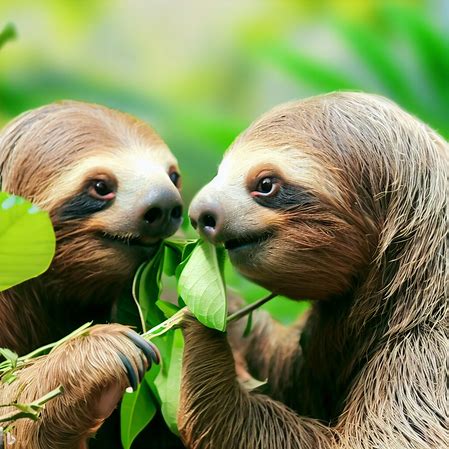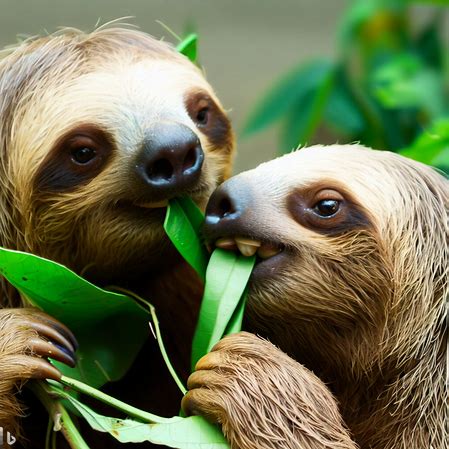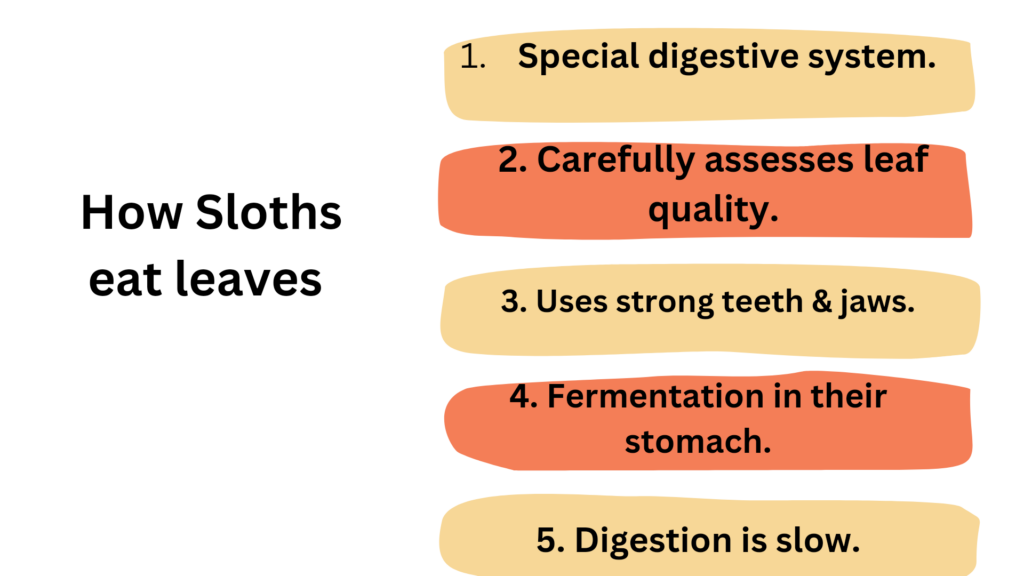
Sloths, those peculiar and captivating creatures known for their slowness, only eat leaves. Their tropical homes are full of foliage, which is perfect for their low energy requirements.
They have a special digestive system to help them extract the maximum nutrition from leaves. This makes it easier for them to digest the cellulose-rich leaves, and conserve energy in the process.
Sloths are incredibly interesting to watch while they feed. They use their long arms to reach for leaves, then use their lips and teeth to bring them to their mouths.
It’s thought that their ancestors were also leaf-eaters, millions of years ago. They have since adapted and refined their leaf-eating techniques.
Why do sloths eat leaves? Because they’ve mastered slow-mo munching, making salad look sexy!
Why do sloths eat leaves?
Sloths have a unique dining choice – leaves! But why? It’s all thanks to their physiology and the abundance of foliage in their environment.
The tough cellulose found in leaves is nutritious and easy to find – perfect for sloths who move slowly. Leaves also provide hydration and energy.
Not all leaves are created equal – sloths have a discerning palate, preferring certain types which are easier to digest and higher in protein.
If you ever meet a hungry sloth, remember these guidelines:
- No human food!
- Let them eat at their own pace.
Also, planting native trees around sloth habitats gives them a sustainable food source and preserves their home.
Move over, Michelin-starred chefs – sloths are the real leaf-eating connoisseurs!
Adaptations of sloths for leaf-eating
Sloths have adapted for leaf-eating with special dental structures, making it possible for them to tear and grind leaves. Plus, their metabolism is remarkably slow, helping them to extract maximum nutrients from their vegetarian diet. They also have an unusually long and complex gut, designed to draw out nutrients from fibrous leaves. And, some species of sloths have been seen practicing coprophagy – eating their own feces – in order to further absorb nutrients through microbial fermentation in the intestines. In essence, sloths have developed the perfect adaptations for leaf-eating!
Types of leaves sloths eat

Sloths have an interesting diet, so let’s take a look into the types of leaves they eat. They can consume leaves from trees such as Cecropia, Guarumo, and Huito.
Cecropia leaves are soft and full of water, making them a major part of a sloth’s diet. Guarumo leaves have lots of proteins and fibers. Huito leaves have vitamins A and C, which are essential for sloths.
Clusia and Trumpet Tree leaves give sloths even more variety and nutrients. Young leaves are easier for them to digest as they have a slow metabolism.
So, if you ever observe sloths eating leaves, remember that they do it slowly and leisurely – like a Netflix binge between bites. Enjoy the nature’s wonders!
How sloths eat leaves

Sloths – fascinating creatures with slow movements and sweet faces. But how exactly do they eat leaves?
- They have a special digestive system that is able to break down tough leaves.
- They carefully assess the leaf’s quality then start chewing.
- Using their strong jaws and teeth, they tear off small pieces, holding it tight.
- Fermentation in their stomachs turns the cellulose in the leaves into nutrients they can absorb.
- Digestion is slow, so they stick to high-calorie leaves that give them most energy with least effort.
Did you know sloths only poop once a week? This is due to their low metabolism. And they prefer one tree for a steady supply of leaves.
An interesting story: researchers watching a three-toed sloth named Diego eating leaves in a tree. Suddenly, he spots something below and quickly goes down, grabbing a snake! Showing how resourceful these creatures can be.
Interesting facts about sloths eating leaves
Sloths have a unique diet. It consists of leaves! These animals are known for their slow digestion process. It can take up to a month for a full meal of leaves to be digested. This is due to their low metabolism. Sloths mainly eat leaves from trees in the rainforest. Their long limbs help them reach their leafy meals. Furthermore, sloths eat leaves high in cellulose content. Such plants require lots of energy to break down. Hence, sloths spend most of their time eating or resting.
Did you know? Sloths have a symbiotic relationship with algae that grows on their fur. This helps them hide in their environment and provides nutrients.
The ancestors of today’s sloths were bigger and lived on land 35 million years ago. They adapted to life in the treetops and developed certain characteristics to survive up there.
Frequently Asked Questions
1. What do sloths eat?
Sloths primarily eat leaves from trees. Their diet consists mainly of high-fiber, low-nutrient leaves that are hard to digest.
2. Why do sloths eat leaves?
Sloths have evolved to eat leaves as their primary food source because trees provide an abundant and constant supply of foliage. The slow metabolism of sloths allows them to extract the minimal nutrients present in leaves.
3. How do sloths eat leaves?
Sloths have specially adapted teeth and jaws to chew and process leaves. They have long, curved claws that help them grip branches while they reach out to grab leaves. Sloths chew their food slowly, and their specially designed stomachs break down the tough leaves over an extended period.
4. Are there any other foods that sloths eat?
Sloths are folivores, meaning their diet is primarily composed of leaves. However, certain species may supplement their diet with fruits, flowers, or even insects for additional nutrients.
5. Do sloths eat all types of leaves?
Sloths have specific preferences when it comes to leaves. They usually consume the leaves of trees such as Cecropia, Guarumo, and Yagrumo. The chemical composition of these leaves makes them more digestible for sloths.
6. How often do sloths eat?
Sloths have a slow metabolism, and they typically spend most of their time resting or sleeping. They eat very slowly and may consume a small amount of leaves each day, usually no more than a few leaves. This is sufficient to meet their low-energy needs.
Conclusion
Sloths, known for their slow pace, eat leaves all day. This ordinary behavior is important for their survival. Leaves provide the energy they need. They also contain microorganisms that help with digestion and keep the sloth healthy.
Sloths’ metabolism has adapted to extract the most energy from leaves. This lets them get the most out of their food and conserve energy. Other animals may also feed on leaves, but none do so with the same dedication as sloths. Studies show they spend 90% of their time eating leaves. This makes them one of nature’s most unique creatures.


